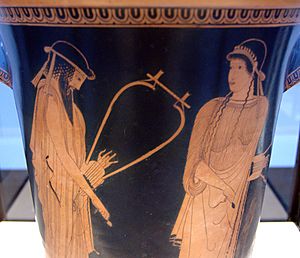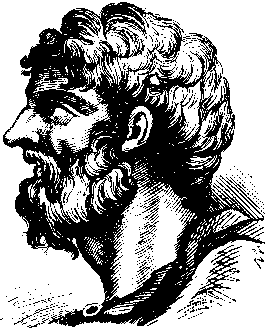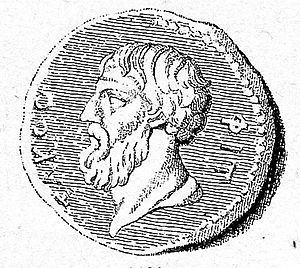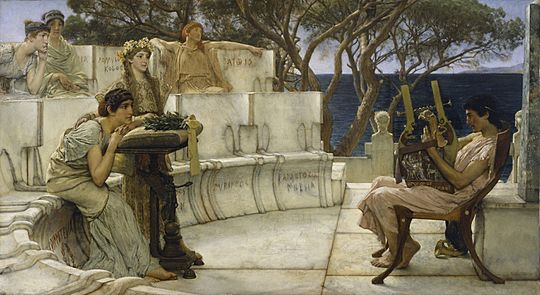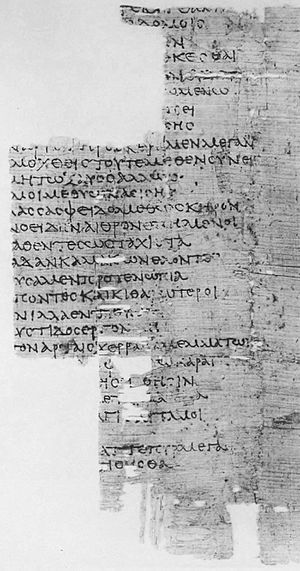Alcaeus of Mytilene facts for kids
Alcaeus of Mytilene (born around 625/620 BC – died around 580 BC) was a famous lyric poet from the Greek island of Lesbos. He is known for creating a special poetry style called the Alcaic stanza. Scholars from ancient Alexandria considered him one of the nine lyric poets who were the best of their time. He lived at the same time as another famous poet, Sappho, and they might have even shared poems with each other. Alcaeus was born into a wealthy and powerful family in Mytilene, the main city on Lesbos. He was very involved in the political fights and disagreements of his city.
Contents
Who Was Alcaeus?
Alcaeus came from a noble family of warriors who ruled Mytilene. Mytilene was the strongest city on Lesbos and had a powerful navy. It also had colonies that helped protect its trade routes. For a long time, kings from the Penthilid family ruled the city. But during Alcaeus's life, other noble families fought for power.
Alcaeus and his older brothers were deeply involved in these political struggles. They didn't have much success. Their political adventures involved three rulers who came and went:
- Melanchrus: He was overthrown between 612 BC and 609 BC. Alcaeus's brothers and Pittacus (who later became one of the Seven Sages of Greece) helped remove him. Alcaeus was too young to join in at that time.
- Myrsilus: We don't know exactly when he became ruler. But Alcaeus's poems show that the poet, his brothers, and Pittacus planned to overthrow him. Pittacus then betrayed them. Alcaeus and his brothers had to leave the city and live in exile. Alcaeus later wrote a song celebrating the news of Myrsilus's death.
- Pittacus: He was the most important political figure of his time. The people of Mytilene voted him supreme power, and he ruled well from 590-580 BC. He even allowed Alcaeus and his group to return home peacefully.
Before 600 BC, Mytilene fought Athens for control of a place called Sigeion. Alcaeus was old enough to fight in this war. The historian Herodotus says that Alcaeus threw away his shield to escape from the winning Athenians. He later wrote a poem about this event and sent it to his friend, Melanippus.
Alcaeus likely traveled a lot during his time in exile, even visiting Egypt. His older brother, Antimenidas, worked as a soldier for hire in the army of Nebuchadnezzar II. He probably took part in the capture of Askelon. Alcaeus wrote poems celebrating Antimenidas's return. He mentioned his brother's bravery in defeating a larger opponent. Alcaeus also proudly described the military weapons displayed in their family home.
Alcaeus and Sappho lived at the same time and were from the same country. Both poets wrote poems to entertain their friends in Mytilene. This meant they often met, for example, at the Kallisteia festival. This was an annual event celebrating the island's unity. Sappho performed there publicly with groups of female singers. Alcaeus referred to Sappho as "holy/pure, honey-smiling Sappho." This might have been inspired by her performances at the festival.
The poetry style from Lesbos "reached its highest point" with Sappho and Alcaeus. Later Greek writers believed the two poets were in love, and this became a popular subject in art.
Alcaeus's Poetry
Scholars in ancient Alexandria collected Alcaeus's poems into ten books. However, today, his poems only exist as fragments. These range from short phrases, like "wine, window into a man," to longer groups of verses. Alexandrian scholars included him in their list of the Nine lyric poets. Many ancient critics thought Pindar was the best, but some preferred Alcaeus.
The nine lyric poets are usually divided into two groups. Alcaeus, Sappho, and Anacreon were "monodists" or "solo-singers." This means:
- They wrote and performed their poems themselves for friends. The poems were about things important to them.
- They wrote in their local dialects. Alcaeus and Sappho used the Aeolic dialect.
- They often used short, simple stanzas, or "strophes," in many poems. This is why we have the "Alcaic" and "Sapphic" stanzas, named after them.
The other six poets wrote for public events, performed by choirs. Their poems often had complex rhythms. However, some modern scholars think this division is too simple. It's hard to know if a poem was sung or recited, or if it had music and dance. Even Alcaeus's personal poems, sung at parties, still had a public purpose.
The Roman poet Horace described Alcaeus as "more full-throatedly singing." Alcaeus himself seemed to show a difference between his own down-to-earth style and Sappho's more heavenly qualities. He described her almost like a goddess. Yet, both poets explored the balance between the divine and everyday life.
Dionysius of Halicarnassus praised Alcaeus for his "sublimity, brevity and sweetness." He also noted Alcaeus's "splendid figures, and his clearness." He especially liked how Alcaeus expressed his feelings on public matters. Quintilian also praised Alcaeus for his skill "where he speaks against rulers and helps good morals." He said Alcaeus's language was "concise, elevated, careful and often like an orator."
Types of Poems
Alcaeus's poems are usually grouped into different types:
- Political Songs: Alcaeus often wrote about politics. He covered the power struggles on Lesbos with great passion. He would curse his opponents, celebrate their defeats, and encourage his friends to be brave. One famous type of political poem used the idea of a "ship of state" to represent the city. Dionysius of Halicarnassus said that if you removed the rhythm from Alcaeus's political poems, they would sound like political speeches.
- Hymns: Alcaeus sang about the gods in a style similar to the Homeric hymns. He wrote these to entertain his friends, not just to praise the gods. He used the same rhythms as his other poems. For example, there are fragments praising the Dioscuri (twin gods), Hermes, and the river Hebrus. The Hebrus river was important in Lesbian stories because it was believed that the singing head of Orpheus floated down it to Lesbos.
- Miscellaneous Poems: Alcaeus wrote about many different topics. This shows the different sides of his personality. For example, the writer Athenaeus quoted verses about perfumes to show how peaceful Alcaeus could be. But he also quoted Alcaeus's description of armor on his house walls to show how warlike he could be. Other examples include poems celebrating his brother's brave acts as a soldier for hire in Babylon. He also wrote poems in the voice of a distressed girl. He even wrote about Homeric stories, comparing Helen of Troy unfavorably with Thetis, the mother of Achilles.
A Hymn (Fragment 34)
Alcaeus rarely used metaphors or similes. But he liked the idea of a storm-tossed ship representing the city. The following poem is a hymn to Castor and Polydeuces (the Dioscuri). It might be another example of the "ship of state" idea. Some scholars, however, think it's a prayer for a safe journey.
Hither now to me from your isle of Pelops,
You powerful children of Zeus and Leda,
Showing yourselves kindly by nature, Castor
And Polydeuces!
Travelling abroad on swift-footed horses,
Over the wide earth, over all the ocean,
How easily you bring deliverance from
Death's gelid rigor,
Landing on tall ships with a sudden, great bound,
A far-away light up the forestays running,
Bringing radiance to a ship in trouble,
Sailed in the darkness!
This poem was written in Sapphic stanzas. This verse form is often linked to Sappho, but Alcaeus also used it very well. The English translation tries to keep the same rhythms. The original poem probably had three more stanzas, but only a few letters remain. The "far-away light" refers to St. Elmo's fire. Ancient Greek sailors believed this electrical discharge was a sign that the Dioscuri gods were present. This poem doesn't start with a verb but still shows a sense of action. Alcaeus likely performed his poems at parties for friends and political allies. Loyalty was very important to these men, especially during such difficult times.
Tributes from Other Poets
Horace's View
The Roman poet Horace based his own poems on Alcaeus's style. He translated Alcaeus's verse forms, like the 'Alcaic' and 'Sapphic' stanzas, into short Latin poems. Horace celebrated this achievement in his third book of odes. In another poem, he imagined meeting Alcaeus and Sappho in Hades (the underworld):
|
quam paene furvae regna Proserpinae |
How close the realm of shadowy Proserpine |
Ovid's View
Ovid compared Alcaeus to Sappho in his work Letters of the Heroines. In this work, Sappho is imagined to say:
|
nec plus Alcaeus consors patriaeque lyraeque |
Nor does Alcaeus, my countryman and fellow poet, |
How We Know About Alcaeus
The story of Alcaeus is also the story of the scholars who saved his work. His poems didn't survive in full books copied over many generations. Instead, they survived in small pieces. These pieces came from quotes by ancient scholars whose own writings happened to survive. They also came from torn pieces of papyri found in ancient trash heaps in places like Oxyrhynchus in Egypt. Modern scholars have studied these fragments carefully, slowly adding to what we know about his poetry.
Ancient scholars quoted Alcaeus to support their ideas. For example, Heraclitus "The Allegorist" quoted parts of poems about ships in a storm. This was for his study on how Homer used allegory. The hymn to Hermes was quoted by Hephaestion. Both he and Libanius quoted the first two lines of a poem celebrating Alcaeus's brother returning from Babylon. The rest of that poem was summarized in prose by the historian Strabo.
The first "modern" collection of Alcaeus's poems appeared in 1556. It was a Greek and Latin edition of fragments collected by Michael Neander. Many other editions followed over the centuries.
In the 1800s, scholars started combining fragments from different sources. For example, two separate quotes by Athenaeus were put together by Theodor Bergk to form one poem. Three different sources were combined to form another poem, including a summary from Strabo that needed to be changed back into its original poetic rhythm.
The discovery of the Oxyrhynchus papyri in the late 1800s greatly increased what scholars knew. Eight important fragments have now been put together from these papyri. These fragments often have gaps. Scholars fill these gaps with "educated guesses." For example, Maurice Bowra made a "brilliant addition" to a hymn to the Dioscuri. This poem includes a description of St. Elmo's fire on a ship's ropes. Working with only a few letters, Bowra created a phrase that improved the poem's meaning and sound. He described the light "running along the forestays."
Images for kids
See also
 In Spanish: Alceo de Mitilene para niños
In Spanish: Alceo de Mitilene para niños


